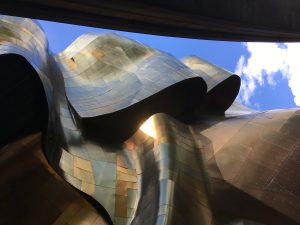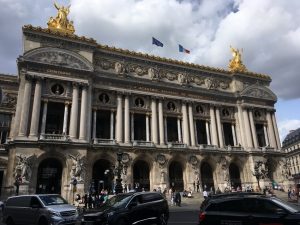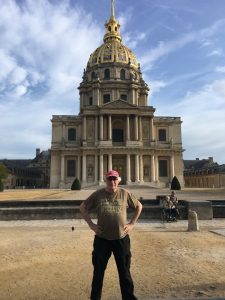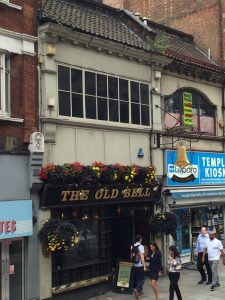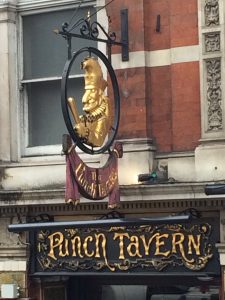Tag Archive
activity architecture art artist building Canada children city CostSaver downtown drive i-95 entertainment Europe event exhibit family festival Florida food fun historic History landmark local Museum music Nature New Zealand Ontario roadtrip sculpture Seattle show sights sightseeing tour tourist Trafalgar travel travelblogger view Washington Washington State water world
US: Seattle, WA – MoPop’s Space Needle
No Frank Gehry did not salute the Seattle Space Needle by building it into his architectural plans of MoPop. That’s the actual Space Needle in this tromp l’oeil shot.
US: Seattle, WA – Views of Space Needle
US: Seattle, WA – Rippling Sheet Metal at MoPop
Architect Frank Gehry’s signature metallic swoops and swirls allow for great sculptural photographs of the Museum of Pop Culture in Seattle.
US: Seattle, WA – Fantastical Museum in Seattle
When architect Frank Gehry designs a building, it’s more than a building, it’s a sculpture. Here in Seattle, the Museum of Pop Culture certainly stands out in the city.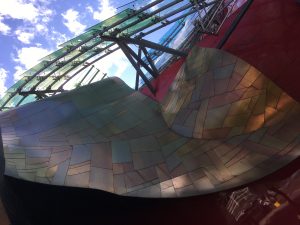
France, Paris: Approaching the Opera de Paris
.
Heading down the Boulevard des Capuchines toward the Opera de Paris is still one of those OMG moments. It is way grander than you imagined.
France, Paris: Paris Opera Charles Garnier Sculpture
.
This monument on the side of the Opera de Paris is dedicated to its architect, Charles Garnier. We loved the idea of putting the seating plan front and center.
France, Paris: Opera de Paris
.
World over it’s known as the Opera de Paris however it does have a real name, the Palais Garnier named for its architect, Charles Garnier, and was built from 1861 to 1875. It became even more famous because of Gaston Leroux’s 1910 novel The Phantom of the Opera and, especially because of the later adaptations in films and the popular 1986 Broadway musical. It is as much a symbol of Paris as Notre Dame Cathedral, the Louvre, or the Sacré-Cœur Basilica.
France, Paris: Hotel des Invalides
.
Les Invalides or Hôtel des Invalides is a vast complex of buildings in Paris including museums and monuments relating to the military history of France. As per its name it was originally built by Louis XIV as a hospital and a retirement home for war veterans. Pictured here is the Dôme des Invalides, a large church, the tallest in Paris which contains the tombs of some of France’s war heroes, most notably Napoleon.
The complex had 15 courtyards for military parades. At the church, attendance was mandatory. Louis XIV also commissioned his architect Mansart to construct a separate royal chapel referred to as the Église du Dôme from its most striking feature (pictured). By combining a royal chapel with a veterans’ chapel, the King and his soldiers could attend mass at the same time while entering the place of worship though different entrances, as prescribed by court etiquette at that time.
I’d like to think the gentleman sitting there (in the wheelchair and on the bench) are two of our veteran heros..
Great Britain, London: London Pubs
.
Pubs are inexpensive places to grab a bite and a beer in London. Some of them are hundreds of years old. Notice the wrought iron bell above The Old Bell tavern and the caricature of Punch on Punch Tavern. Many people back then were illiterate so objects were hung to create easy way for them to find shops and pubs. We passed these on Fleet Street while aboard the Hop On Hop Off Bus which was included in the London Pass.
The Bell Tavern was built by architect Sir Christopher Wren in the 1670’s while he was working on the churches nearby. Since it is located on the famous Fleet street which was the epicenter of the newspaper industry, the writers and inkies(printers), penned their copy here while probably perennially hammered.
Punch Tavern got it’s name in the 1840’s as Punch magazine had its office here on Fleet Street. There was a pub here even before then called the Crown and Sugar Loaf.
US: Lincoln, MA -See Bauhaus Home Furnishings In Bauhaus Home – National Historic Landmark
If you’re a fan of architecture and design you’ll want to check out The Gropius House. Walter Gropius, the founder of the highly influential Bauhaus School and one of the most prominent architects of the 20th century designed this striking home in 1938 after moving from Germany to Massachusetts to teach at Harvard’s Graduate School of Design.
Modest in scale, the house was revolutionary in impact. It combined the traditional elements of New England architecture — wood, brick, and fieldstone, with innovative materials rarely used in domestic settings at that time: glass block, acoustical plaster, and chrome banisters, along with the latest technology in fixtures. 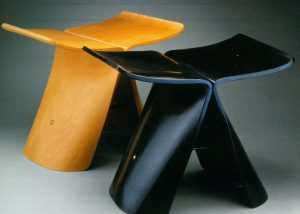
At the Gropius House, Bauhaus ideals remain alive, and throughout Gropius’s life, he and his wife Ise continued to add newly designed furnishings that reflected their belief in the marriage of design and industry. In keeping with Bauhaus philosophy, every aspect of the house and its surrounding landscape was planned for maximum efficiency and simplicity of design. 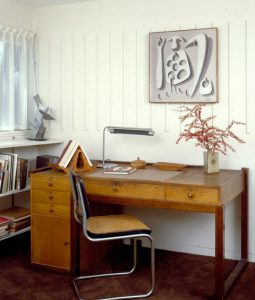
Two years after Mrs. Gropius’s death in 1983, the Gropius House opened as a historic house museum. The house contains a significant collection of furniture designed by Marcel Breuer and fabricated in the Bauhaus workshops. The house also contains works by Eero Saarinen, Joan Miró, and Herbert Bayer that were given as gifts to Walter Gropius. With all the family possessions still in place, the house has an cohesiveness rarely found in house museums.
All images are “Courtesy of Historic New England.”
Location: Gropius House. 68 Baker Bridge Road, Lincoln, Mass. 01773
Dates: Sat and Sun, until May 31
Hours: 11 – 4pm, Tours on the hour
Tel: 781-259-8098
historicnewengland.org/historic-properties/homes/Gropius%20House
For Regional Information, Restaurants & Attractions: merrimackvalley.org

